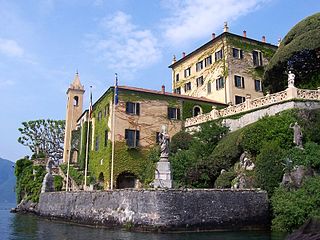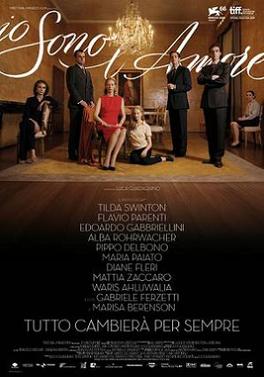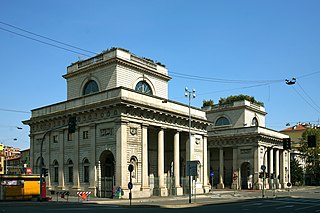
Via Monte Napoleone, also spelled Via Montenapoleone, is an upscale shopping street in Milan, Italy, Europe's most expensive street and the second most expensive street in the world after Fifth Avenue in New York City (2023). It is famous for its ready-to-wear fashion and jewelry shops, and for being the most important street of the Milan fashion district known as the Quadrilatero della moda, where many well-known fashion designers have high-end boutiques. The most exclusive Italian shoemakers maintain boutiques on this street.
The year 1935 in architecture involved some significant architectural events and new buildings.

The Fondo Ambiente Italiano (FAI) is the National Trust of Italy.

Formello is a comune (municipality) in the Metropolitan City of Rome Capital. It is located southwest of the Monti Sabatini, within the Regional Park of Veii. The communal territory sits on large deposits of tuff, which is intensively mined in the area.

The Villa del Balbianello is a villa in the comune of Lenno, a province in the north of the Lombardy region of Italy, overlooking Lake Como. It is located on the tip of the small wooded peninsula of Dosso d'Avedo on the western shore of the south-west branch of Lake Como, 1500 meters east from the Isola Comacina. The villa is famous for its elaborate terraced gardens.

I Am Love is a 2009 Italian romantic drama film directed by Luca Guadagnino, set in Milan around the year 2000. Tilda Swinton plays a rich industrialist's wife who has an affair with a chef. It is the first installment in Guadagnino's self-described Desire trilogy, preceding A Bigger Splash (2015) and Call Me by Your Name (2017). Producers Swinton and Guadagnino developed the film together over an 11-year period. The film's soundtrack uses pre-existing compositions by John Adams.

Villas and palaces in Milan are used to indicate public and private buildings in Milan of particular artistic and architectural value. Milan has always been an important centre with regard to the construction of historical villas and palaces, ranging from the Romanesque to the neo-Gothic, from Baroque to Rococo.

Porta Venezia is one of the historical gates of the city of Milan, Italy. In its present form, the gate dates back to the 19th century; nevertheless, its origins can be traced back to the medieval and even the Roman walls of the city.
Riccardo Beretta is an Italian artist born in 1982 in Mariano Comense, Como, Italy. He lives and works in Milan.

Casa degli Omenoni is a historic palace of Milan, northern Italy, located in the eponymous street of Via degli Omenoni. It was designed by sculptor Leone Leoni for himself; he both lived and worked there. It owes its name to the eight atlantes decorating its facade, termed "omenoni", which were sculpted by Antonio Abondio, most probably on a design by Leoni. Lions are a recurring theme of its decorations; in particular, a large relief placed under the cornice depicts two lions tearing a satyr into pieces. The overall style of the palace and the decorations have been noted to include several references to the art of Michelangelo. The internal courtyard, modified in 1929 by Piero Portaluppi, has a colonnade with metopes and triglyphs.

Neoclassical architecture in Milan encompasses the main artistic movement from about 1750 to 1850 in this northern Italian city. From the final years of the reign of Maria Theresa of Austria, through the Napoleonic Kingdom of Italy and the European Restoration, Milan was in the forefront of a strong cultural and economic renaissance in which Neoclassicism was the dominant style, creating in Milan some of the most influential works in this style in Italy and across Europe. Notable developments include construction of the Teatro alla Scala, the restyled Royal Palace, and the Brera institutions including the Academy of Fine Arts, the Braidense Library and the Brera Astronomical Observatory. Neoclassicism also led to the development of monumental city gates, new squares and boulevards, as well as public gardens and private mansions. Latterly, two churches, San Tomaso in Terramara and San Carlo al Corso, were completed in Neoclassical style before the period came to an end in the late 1830s.

Piero Portaluppi was an Italian architect. He is known for his prolific output, having designed over 100 buildings in Milan.

The Villa dei Vescovi is a Renaissance-style, rural palatial home located in the neighborhood or frazione of Luvigliano, within the city limits of Torreglia, province of Padova, region of Veneto, Italy. Initially built for the archbishops of Padua, the villa is now owned by the Fondo Ambiente Italiano (FAI), and the grounds and frescoed rooms are open to visitors and guests.

The Albergo diurno Venezia is a structure built under Piazza Oberdan in Milan, on the western side towards Via Tadino.
Domitilla Harding is an Italian designer and artist.

The Castellini Baldissera are a historic family, originating from Milan and Brescia.

Palazzina Appiani is a historical building located in Milan, northern Italy. It was built as the entrance hall of the arena at the beginning of the 19th century by the French, who occupied Milan in 1796. Its original function was to be the official gallery and guest residence to host Napoleon's family during his public appearances. It is located in Parco Sempione, the biggest park in the city, which also comprises the Sforza Castle and the Arch of Peace. Adjacent to the Arena Civica, the Palazzina is now entrusted to FAI – Fondo Ambiente Italiano.

Giuseppe Palanti was an Italian painter, illustrator, and urban planner, best known for his portraits, notably of Mussolini and Pius XI. He had a long collaboration with Teatro alla Scala in Milan, creating costume, set design and advertising material for multiple opera productions. He was also a major contributor towards the development of the seaside resort Milano Marittima.
Villa Martuzzi or Villa Martuzzi-Ripanelli is a rural palace house located in on the Via Emilia Piacentina, in the neighborhood of Collina di Campiglio, just outside of the town of Vignola, near Modena, Region of Emilia-Romagna, Italy.

The Bicocca degli Arcimboldi is an aristocratic villa built in the second half of the 15th century as the country residence of the Famiglia degli Arcimboldi. Once situated in a totally rural area not far from Milan, it is now located within the homonymous district, in a now totally urbanised context.



















